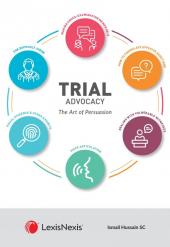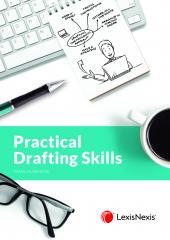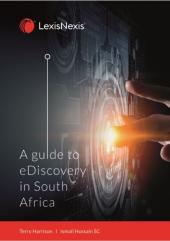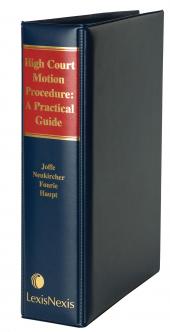Trial Advocacy: The Art of persuasion
What does it take to persuade a judge to accept your client's version of the facts? The answer is in this publication.
Select a format
One Year Subscription Only Terms
Subscribers receive the product(s) listed on the Order Form and any Updates made available during the annual subscription period. Shipping and handling fees are not included in the annual price.
Subscribers are advised of the number of Updates that were made to the particular publication the prior year. The number of Updates may vary due to developments in the law and other publishing issues, but subscribers may use this as a rough estimate of future shipments. Subscribers may call Customer Support at 800-833-9844 for additional information.
Subscribers may cancel this subscription by: calling Customer Support at 800-833-9844; emailing customer.support@lexisnexis.com; or returning the invoice marked 'CANCEL'.
If subscribers cancel within 30 days after the product is ordered or received and return the product at their expense, then they will receive a full credit of the price for the annual subscription.
If subscribers cancel between 31 and 60 days after the invoice date and return the product at their expense, then they will receive a 5/6th credit of the price for the annual subscription. No credit will be given for cancellations more than 60 days after the invoice date. To receive any credit, subscriber must return all product(s) shipped during the year at their expense within the applicable cancellation period listed above.
Product description
What does it take to persuade a judge to accept your client's version of the facts? The answer is in this publication.
Knowing what to say is just the beginning for a lawyer. True effectiveness lies in mastering the art of persuasion. This invaluable resource combines facts with practical know-how to empower practitioners to excel in civil and criminal proceedings.
Discover techniques that will elevate your presence, making you look, sound, and feel natural and polished. Whether you're a candidate, pupil, or seasoned practitioner, this essential reading equips you with the skills to become a more effective trial lawyer. Don't miss out on this must-have guide to practice and polish your trial-related skills in the most practical and effective way. Elevate your courtroom performance and achieve success.
This unique title reveals the secrets to courtroom success. Master virtual hearings and leverage technology for impactful presentations. Seamlessly handle electronic documents and evidence. Engage with captivating case studies. Elevate your skills and address the courtroom with confidence.
Available in print, ebook and online formats. Online format must be added to a Lexis+ base package. Visit www.lexisnexis.co.za/lexisplus for more information.
Table of contents
CHAPTER_1 -
Voice and Pronunciation
CHAPTER_2 -
Introduction
Where does Trial Advocacy fit
Understanding the Adversarial System
The Method
The Role of the Judge
The Facts
The Adversarial System
The Judicial Officer
The Trial Lawyer
CHAPTER_3 -
Case Analysis
Telling the Story
Preparation
CHAPTER_4 -
Obtaining Instructions
The Papers
For A Civil Case
For a Criminal Case
The Issues
Obtaining the Facts
Case Concept
Case Study number 1
The Method
CHAPTER_5 -
Taking Instructions
The Method
What About Witnesses
CHAPTER_6 -
The Balance of Probabilities
How Do Judges Approach This?
CHAPTER_7 -
Opening Statement
Civil Cases
CHAPTER_8 -
The Evidence in Chief
The Witness
Witness Briefing
What is the Judge Thinking?
How Judges Weigh Evidence
What is the Judge Looking At?
CHAPTER_9 -
Leading Your Witness in Chief
What are the Main Objectives?
Witness Must be Qualified
What is Evidence in Chief
You Want to be Persuasive
The Question
The Leading Question
Open Questions
Closed Questions
The Effective use of Questions
The Technique
Managing the Paper
The Digital Era
Types of Questions
The Headline Method
The Looping Back Method
The Closed Question
Repeating the Answer
Knowing your Objective
Know When to Stop
Communicating with the Judge
What to Do – a summary
CHAPTER_10 -
Exhibits and other Visual Evidence
Case Management
Collection of Exhibits
Court Technique
You Are on Your Feet
The Necessary Steps
CHAPTER_11 -
eDiscovery
Presenting Electronic Documents
CHAPTER_12 -
Expert Witnesses
The Judge
Preparation
Preparing the Expert
Your Own Preparation
The Formula
Analysis
Leading in Chief
The Method
Qualifying the Expert
Using Leading Questions
The Disputed Issues
Sources of Information
The Opinion
Reasons for the Opinion
Changing the Facts
The Consensus Approach
CHAPTER_13 -
Cross-examination
The Judicial Eyes and Ears
Judges Hate This
Weight as Proof of a Fact
Demeanour
How do Judges Deal with It?
What Not to Do
Purpose of Cross-examination
Listening to the Evidence in Chief
The Questions and Method
Identification
What not to do
The Bad Question
Dealing with your Client's Version
Previous Inconsistent Statements
Expert Witnesses
Challenging the Experts Conclusions
CHAPTER_14 -
The Difficult Witness
The Difficult Judge
CHAPTER_15 -
Re-examination
CHAPTER_16 -
Visual Aids and Exhibits
Communication and Technology
How to use Visual Evidence and other Exhibits
Proving Disputed Exhibits
Electronic Evidence
In Loco Inspections
CHAPTER_17 -
Vulnerable Witnesses
In Chief
Beware the Tag Questions
The Inhibit Choice Question
CHAPTER_18 -
Interpreters
CHAPTER_19 -
Presenting Final Argument
The Judge
What Not to Do
Voice Posture and Pace
CHAPTER_20 -
On Motion
Unopposed Motions
Preparation to Move an Unopposed Motion
The Protocols in an Unopposed Motion Court
How to Move an Unopposed Motion
CHAPTER_21 -
Opposed Motion Court
The Judge
The Judge's File
Preparing to Appear
You are on your Feet
Referral to Trial or Evidence
CHAPTER_22 -
Urgent Applications
After Hours Applications
When Opposed?
CHAPTER_23 -
Virtual Hearings
The SCA Directives
Performing While Sitting Down
The Question of Demeanour
Leading the Witness
Cross-examining a Face on a Screen
Presenting Argument While Sitting Down
CHAPTER_24 -
Performance Anxiety
CHAPTER_25 -
Ethics for Trial Lawyers
CHAPTER_26 -
Digital Assistance in Court
CHAPTER_27 -
Training Trial Lawyers




